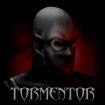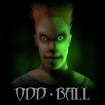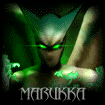mNo edit summary |
mNo edit summary |
||
| Line 10: | Line 10: | ||
====Damage Reduction==== | ====Damage Reduction==== | ||
Players who are in a juggled state or on the ground receive 40% less damage, rounded down. | Players who are in a juggled state or on the ground receive 40% less damage, rounded down. This reduction is applied after the bonus damage is applied, which is important to note since the damage gets rounded down. | ||
---- | ---- | ||
Revision as of 12:09, 21 April 2023
Damage
Characters in Thrill Kill don't have health bars, and one character doesn't have more health than any other. Instead, rounds are won by dealing damage, which is added to your bloodlust meter. Once you deal 100 damage, you win the round. In a multiplayer game, you then grab one of the remaining players in the game and Thrill Kill them - removing them from the match.
Bonus Damage
Special moves, which are moves that require one or more direction inputs to perform, deal double damage if they're linked into from a combo string. For example, Belladonna's Vegas Vertical (![]()
![]()
![]() ) deals 6 damage on its own. However, when strung into using
) deals 6 damage on its own. However, when strung into using ![]()
![]()
![]()
![]()
![]()
![]()
![]()
![]()
![]() , Vegas Vertical deals 12 damage instead. This means strings with a lot of linked specials can rack up damage very quickly, and certain moves in particular can deal a ludicrous amount of damage using this mechanic.
, Vegas Vertical deals 12 damage instead. This means strings with a lot of linked specials can rack up damage very quickly, and certain moves in particular can deal a ludicrous amount of damage using this mechanic.
Sometimes a string will end with a special move, even though a different input was used to string it. For example, Tormentor has a ![]()
![]()
![]()
![]()
![]() string that ends with a Spin Kick attack, even though that move is performed with
string that ends with a Spin Kick attack, even though that move is performed with ![]()
![]()
![]() . If you input
. If you input ![]()
![]()
![]()
![]()
![]()
![]()
![]() instead, you get the same string, but the final hit will deal double damage.
instead, you get the same string, but the final hit will deal double damage.
Strings that use ![]()
![]()
![]() or
or ![]()
![]()
![]() for special move linkers don't get bonus damage.
for special move linkers don't get bonus damage.
Damage Reduction
Players who are in a juggled state or on the ground receive 40% less damage, rounded down. This reduction is applied after the bonus damage is applied, which is important to note since the damage gets rounded down.
Blocking
While the L1 button manually blocks, your character will automatically block any attacks as long as you're not holding a direction or performing an action. Standing still will automatically block ![]() and
and ![]() attacks, while crouching will block
attacks, while crouching will block ![]() attacks. This makes the block button largely useless, with the exception of pressing it during a dash to cancel it and immediately begin blocking (note this does not reset the dash cooldown like pressing crouch does).
attacks. This makes the block button largely useless, with the exception of pressing it during a dash to cancel it and immediately begin blocking (note this does not reset the dash cooldown like pressing crouch does).
Crouching
Crouching is performed by holding ![]() . High attacks and grabs will always whiff crouching players. However, a lot of characters lack good attacks or strings from a crouching position, so being able to launch or hard knockdown an opponent from a crouching position (either through a single move or a string) is considered a very valuable asset to the character.
. High attacks and grabs will always whiff crouching players. However, a lot of characters lack good attacks or strings from a crouching position, so being able to launch or hard knockdown an opponent from a crouching position (either through a single move or a string) is considered a very valuable asset to the character.
Dashing
Dashing is performed by double tapping a direction. This is the fastest way to move in the game, however dashing has a fair bit of endlag before you can move again, and it has a short cooldown before another dash can be attempted after this endlag. However, both of these downsides can be completely negated with some tricks.
Dash Canceling
Pressing ![]() to crouch will cancel the momentum of the dash, but it will cut any endlag as well as reset your dash timer, allowing you to immediately dash again once you release crouch. If used near the end of the dash once your character starts slowing down, very lightly pressing crouch and then inputting another dash allows you to greatly speed up your momevement.
to crouch will cancel the momentum of the dash, but it will cut any endlag as well as reset your dash timer, allowing you to immediately dash again once you release crouch. If used near the end of the dash once your character starts slowing down, very lightly pressing crouch and then inputting another dash allows you to greatly speed up your momevement.
R-Canceling
The R1 and R2 buttons are not bound to any action, and do nothing in game. However, they have a weird quirk that when pressed interrupts how the game checks to see which inputs you've pressed recently. : This means that you can perform a dash, press either R button, and then immediately halt the dash to begin attacking with a normal instead of a dash attack. This allows you to extend the range of normal dramatically, rewarding good spacing with devastating punishes. R-Canceling is not necessary for command moves that use one or more directional inputs.
Counters
Counters are a defensive tool that can be enabled or disabled in the options menu. Every character has access to two different kinds of counters, which can be used in two different ways: Parries and Breakers.
Pressing ![]()
![]()
![]() will parry
will parry ![]() and
and ![]() attacks, and
attacks, and ![]()
![]()
![]() will parry
will parry ![]() attacks.
When a successful counter is performed, it executes a universal move that deals 15 damage and causes a hard knockdown to any opponent caught in its large hitbox. Counters last 7f, however the game only checks to see if you're currently in this 7f window before beginning another counter, which means with proper timing you can constantly be in a countering state, even if your animation doesn't portray you doing so. A common camping tactic is to hold crouch while constantly switching between countering high and low.
attacks.
When a successful counter is performed, it executes a universal move that deals 15 damage and causes a hard knockdown to any opponent caught in its large hitbox. Counters last 7f, however the game only checks to see if you're currently in this 7f window before beginning another counter, which means with proper timing you can constantly be in a countering state, even if your animation doesn't portray you doing so. A common camping tactic is to hold crouch while constantly switching between countering high and low.
Parrying
Parrying is performed by pressing either counter input when you're not in an attack animation or in or hitstun, and can be performed while crouching. Parrying will perform an animation where your character reels back, but this same animation plays whether you're parrying high or low, allowing you to mask which parry you're using. You are unable to move, attack, or block during the parry animation.
Breakers
Counter inputs can be performed even when you're in hitstun and actively being attacked by another player. A combo string can be countered out of when the string switches from a ![]() or
or ![]() attack to a
attack to a ![]() attack, or vice versa. Pressing
attack, or vice versa. Pressing ![]()
![]()
![]() counters the change to a
counters the change to a ![]() or
or ![]() , and
, and ![]()
![]()
![]() counters a change to a
counters a change to a ![]() attack.
attack.
This mechanic keeps (almost) all of the 0-to-death combos characters possess in check, as most of them contain several opportunities for victims to counter out of them. This also adds a lot of value to characters that possess several combo paths from their buttons, allowing them mix their opponent up of when to counter high or low.
The combo strings present on each of the character pages will denote where in the string an attack can be high or low countered. Inputs coloured cornflower blue can be high countered, and inputs coloured light coral can be low countered. For example, this Tormentor string has two opportunities to counter out of it after the first hit:
Strings that possess no ways to counter out of them after the first hit are considered "safer", and thusly more desirable.










